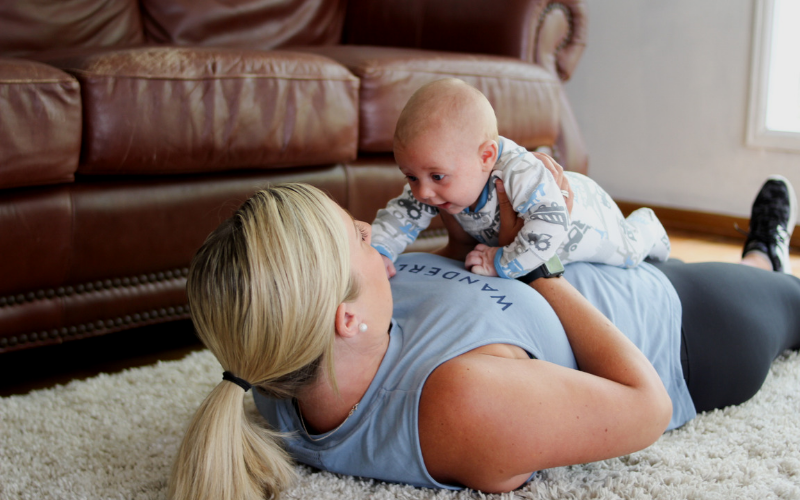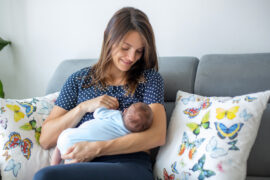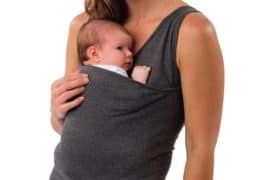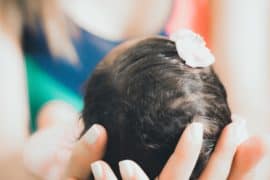Keeping both you and your baby healthy while breastfeeding requires a proper meal plan and some guidance. If you would like a step-by-step program to help you lose weight safely, check out all our courses, programs, challenges, & recipe book.
This post is written by my friend and amazing physical therapist, Dr. Jena Bradley, DPT. Make sure to check out her FREE 5-Day Restore Your Core program to jump-start you into healing and working out.
Did you just recently have a newborn baby and have been wondering when is the right time to start working out again? Knowing when to start working out after having a newborn is not a one size fits all kind of answer. And starting a postpartum workout is not something you just do without having some medical guidance from a professional. I’m a physical therapist, and I want to make sure you are fully educated on how to start a postpartum workout routine safely so that you not only feel good now but will ultimately continue to feel good every day in the future. By the time you are done reading this article, you will know exactly when it is safe to begin working out postpartum.
Understanding Your Pregnancy
The big question is: “how was your pregnancy?” Did you have an amazing, rockstar pregnancy or was your pregnancy a little on the bumpy side (no pun intended!)?
How you felt during your pregnancy will actually play a role in how well your postpartum recovery will go.
For example, if you started to develop back pain in your third trimester, your muscles will begin to weaken as the pain gets worse. With those weak muscles, other parts of your body may begin to hurt because of over-compensation from the added baby weight and back pain issues.
Unfortunately, these types of problems do not go away overnight after you deliver your baby. The muscles in your back will take time to strengthen and repair as you begin your new normal as a new mom and a mom with a postpartum belly.
A mom who has suffered a lot of pain during pregnancy will take extra time to recover during postpartum. This type of mom will need to take her postpartum workouts slower in order to monitor her tolerance to each workout before beginning a new exercise.
However, a mom who went through pregnancy without one complaint of pain the entire 9 months may feel great the first 4 weeks after childbirth and is ready to start doing a 20-minute workout routine the moment her doctor gives her the go-ahead. This kind of mom will obviously progress faster with her postpartum workouts since pain is not limiting her in any way.
The big takeaway is to understand that your pregnancy condition should definitely be taken into consideration when deciding when to start your postpartum workouts. If your pregnancy was not an easy one, then definitely don’t feel the need to rush into your first postpartum workout.
Childbirth, Labor, and Delivery Side Effects
Childbirth is a moment in your life that you’ll never forget. There’s so much joy even when there is so much pain. But I hope you didn’t have too much pain.
Labor and delivery can go in so many different directions for women. Maybe you had natural childbirth and your baby miraculously came right out with one push. Or perhaps you spent almost 48 hours in the delivery room just waiting for some crowning to occur. You may have had to have an unplanned C-section that you never imagined could have happened since you were so prepared.
Did you have any complications with your birthing experience: perhaps some tearing, excessive bleeding or negative side effects to the epidural? Whatever you might have gone through during childbirth, your labor and delivery experience will have a direct effect on your postpartum recovery.
Unfortunately, we never know which way things are going when it comes to childbirth. It’s like you are going into the unknown. You may have one vision for the perfect childbirth experience, but things completely do a “180” and nothing was ever checked off on your birth plan. Sometimes we have no control over the direction of delivery, and we just have to accept that. But whatever happens, we know that our bodies can do amazing things and we will soon get back on our feet.
So when are you allowed to get up on your feet to do your first postpartum workout after having a difficult childbirth experience?
I recommend using your pain as your guide. The reason why our bodies experience pain is that our bodies are trying to talk to us about what is actually going on inside. If we didn’t have pain, then we wouldn’t know if there was ever something wrong, like an injury or a problem with one of our organs. So I encourage you to start paying attention to your pain levels and monitor your pain on a daily basis after childbirth.
You can do this simply by grabbing a little calendar of some kind or marking it on your phone under the calendar app. Each day rank your pain from 0-10.
- 0 – No Pain
- 1 – Minimal
- 2 – Mild
- 3 – Uncomfortable
- 4 – Moderate
- 5 – Distracting
- 6 – Distressing
- 7 – Unmanageable
- 8 – Intense
- 9 – Severe
- 10 – Unable to move
The goal is to see your pain number scale go down with each passing week. Rank the pain for your entire body or rank the pain for a specific body part.
If you start to see the pain going down close to 0 out of 10 then you know you are getting close to being ready for your first postpartum workout.
I would never advise any postpartum woman to begin working out so soon after childbirth when they still have pain scores of 5 or above. That’s an indication that your body is not fully healed and your body needs to rest. Let the natural processes of healing do their thing before you begin your first postpartum workout.
But there is one more thing you need to do before you begin your first workout after having a newborn baby.
6-Week Postpartum Check-Up
I’m a stickler for following doctor’s orders. It’s my job! As a physical therapist, I always do what the doctor recommends, and when it comes to postpartum workouts, the doctors recommend waiting until after the 6-week postpartum check-up before beginning exercise.
Pilates+ Cardio Workout For Postpartum Mamas To Lose Weight and Protect Their Core
There are too many unknowns during the first 6 weeks postpartum to recommend beginning a workout routine during the 6-week wait. I always recommend being on the cautious side rather than rushing into a workout before your body is ready.
Getting the 6-week postpartum exam is very important because your doctor will do an internal exam to see if you are healing properly. Your doctor may want to see if your episiotomy is fully healed if there is any vaginal prolapse if you have diastasis recti or any other residual side effects from pregnancy and childbirth.
If you were to begin working out during the 6-week postpartum wait without that exam, you may have made your condition worse by doing the wrong exercises.
It’s always best to wait, get approval from your doctor and then begin with the proper exercise routine at the right time when your body is fully healed.
The body takes at least 6 weeks to fully heal after childbirth. It may seem like a long time, but that’s the way our bodies work. We can’t rush it. So let your body do what it needs to do to heal.
Criteria For Starting Your First Postpartum Workout
Now that you are healed, your body is ready to begin working out and your doctor gave you approval, I recommend beginning with a simple postpartum exercise.
But before you begin exercising, I want to make sure you fit the criteria for starting postpartum exercise:
- You’re past 6 weeks after childbirth
- You don’t have any residual pain from childbirth or pregnancy
- You are no longer bleeding
- Your episiotomy is fully healed
- Your C-section incision is fully healed
- You have no complications or major diagnosis resulting from childbirth (ex: prolapse)
- You were approved by the doctor at the 6-week postpartum check-up to begin working out
So if you answered yes to all the questions above, you are safe to begin your first postpartum exercise. Like I said earlier, there is no “one size fits all” kind of answer for when you are allowed to begin working out postpartum. There are a lot of important factors that play a role in the decision. This program is amazing for starting right after the 6-week check-up, or before because of the abdominal and pelvic floor attention.
Ultimately, you don’t want to rush right into exercising after childbirth, and you definitely want to wait until after the doctor sees you at the 6-week postpartum check-up.
Correct Diastasis Recti + Abdominal Separation After Baby Free Cheat Sheet
When you are ready to get started with your first postpartum exercise, I recommend you start with abdominal bracing. This is the foundation to all postpartum core exercises that I explain in my postpartum ab rehab program. You can learn how to do this exercise plus more tips on how to lose the baby weight in my FREE 5-Day Restore Your Core email course
About Dr. Jena Bradley, DPT
Jena is a mom of 4 darling little girls, a physical therapist, and the founder of Live Core Strong, a blog focusing on motivating moms to live a life that incorporates fitness and fun throughout their motherhood journey. She aims to be the friend you always wanted to have who could guide you through the “fog” when faced with an “I don’t know what to do” mommy moment. At the most inconvenient time of her life, she embarked on a journey of sharing her story and expertise to inspire the next generation of healthy moms. You can learn more about Jena by visiting her blog, Live Core Strong.
If you haven’t yet, check out all our courses, programs, challenges, & recipe book!








Comments are closed.